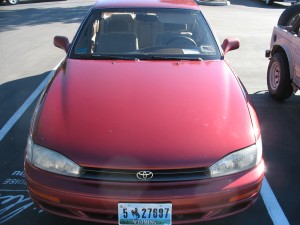Elegy For A Car That Kept Running

Molly Messick / StateImpact Idaho
When StateImpact reporter Molly Messick traded in her old Toyota last fall, it had racked up more than 260,000 miles.
Until recently, my car was a 1994 Toyota Camry that my parents purchased second-hand when I was in high school. By the time I was finished with it, its odometer had passed the 260,000 mile mark. It had been broken into in D.C. and held its own on rutted out back roads all over Wyoming. I probably would have kept driving it, had it not been for a couple of expensive repairs on the horizon.
All of that is to say that when I read this recent New York Times article that declares 200,000 miles the new 100,000, it touched a chord. “[T]oday, as more owners drive their vehicles farther,” the article says, “some are learning that the imagined limits of vehicular endurance may not be real limits at all.” A primary motivation for keeping cars longer is, of course, the economic climate. Frugality’s effects on the used car market have also been widely reported. This story from The Christian Science Monitor, which points out that it is now sometimes cheaper to buy new than used, is only one of several recent examples.
As the New York Times piece points out, underlying all of this is the fact that cars are simply better than they used to be. The story quotes Jagadish Sorab, of Ford Motor.
“Fifteen years ago, piston rings would show perhaps 50 microns of wear over the useful life of a vehicle,” Mr. Sorab said, referring to the engine part responsible for sealing combustion in the cylinder. “Today, it is less than 10 microns. As a benchmark, a human hair is 200 microns thick.
“Materials are much better,” Mr. Sorab continued. “We can use very durable, diamondlike carbon finishes to prevent wear. We have tested our newest breed of EcoBoost engines, in our F-150 pickup, for 250,000 miles. When we tear the engines down, we cannot see any evidence of wear.” – The New York Times
No doubt about it, my Toyota was built to last. But it was simple sentiment — and sure, thriftiness — that made me hold on for so long. When I cleaned it out before trading it in last fall, I found mix tapes made for me by friends in high school. I unloaded my camping gear, and reminisced about nights spent counting shooting stars. When I handed over the keys at the car dealership later that afternoon, they knocked $300 off the price of my new Subaru. It didn’t seem like nearly enough.
Surely you readers out there have old car stories of your own. We’d love to hear them.
